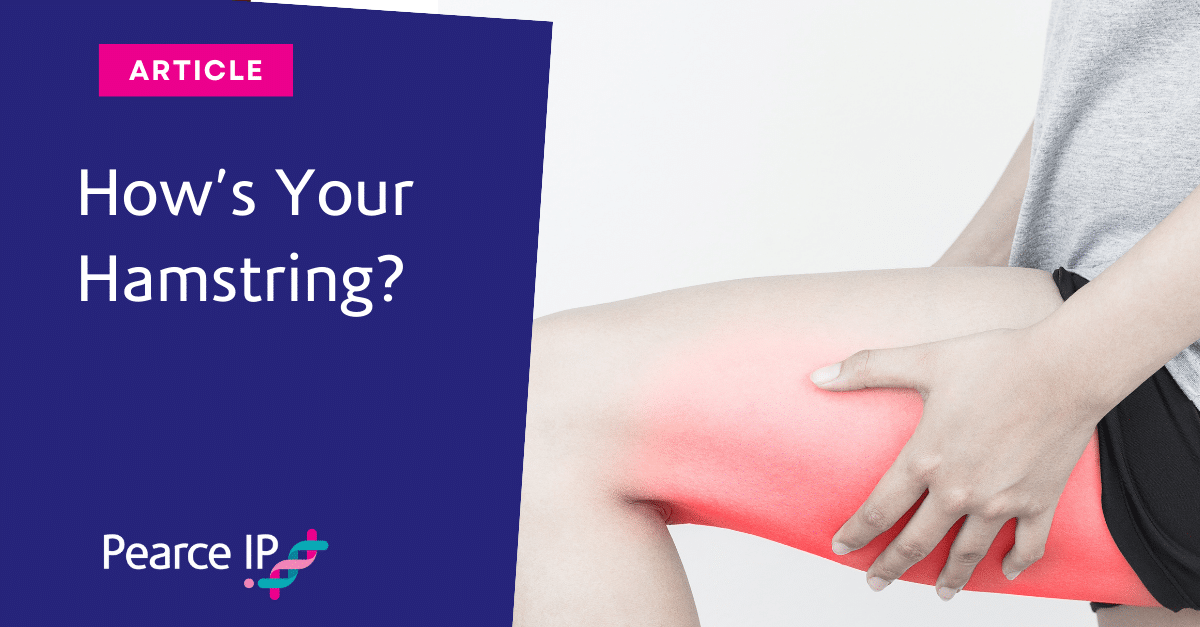Date:
Court:
Adjudicator:
5 April 2024 and 23 April 2024
Federal Court Australia
Downes J
Background
Vald Pty Ltd sued KangaTech Pty Ltd for patent infringement and Kanga cross-claimed alleging that Vald’s patent is invalid on the basis of lack of support, lack of sufficiency and lack of inventive step.
Vald’s Australian patent 2012388708 relates to an apparatus for use in assessing the strength of a knee flexor muscle of a person, and more specifically to an apparatus for assessing hamstring strength while a person performs an eccentric knee flexor contraction.
The primary muscle group that flexes the knee is the hamstring muscle group, and exercises such as ‘Nordic curls’ are used to strengthen the hamstrings which assists in the prevention of hamstring injuries. It is therefore important to be able to determine whether the benefits of these exercises are being achieved, as well as to evaluate the risk of injury. Vald’s invention purports to assist with the detection of hamstring strength and injury.
Kanga develops and sells testing devices to assist athletic performance and the prevention of physical injuries. Vald alleged that Kanga had sold two products which infringed its patent. Following Vald’s allegation, one of those products was subsequently twice modified.
Kanga accepted that, if certain claims of Vald’s patent are valid, its unmodified products (but not its modified products) infringe those claims. It also accepted that, if the Court adopted a certain construction of claim 1, its counter-claim of patent invalidity would fail.
Justice Downes delivered her decision on infringement and validity in Vald Pty Ltd v KangaTech Pty Ltd (No 5) [2024] FCA 333 (the First Decision). Her Honour delivered a separate judgment on orders in Vald Pty Ltd v KangaTech Pty Ltd (No 6) [2024] FCA 408 (the Second Decision).
Key Issues
In the First Decision, the key issues centred on the expert evidence filed by the parties and claim construction.
Vald filed expert evidence from an experienced physiotherapist and academic. Kanga filed expert evidence from an experienced sports scientist and academic. Important parts of the experts’ evidence differed and, where that occurred, the Court favoured the evidence of Kanga’s expert.
The Court noted that the primary role of independent experts is to assist the Court in ‘understanding the technical background to, and the purpose of, the invention’. After considering the expert evidence (both written and oral), the Court found that Kanga’s expert ‘gave careful and considered answers to questions asked of him during the hearing, appeared to be attempting to assist the Court and, by his answers and general demeanour, did not appear to be favouring any party or outcome in the dispute’. In contrast, the Court found that Vald’s expert did, at times, ‘appear to be seeking to assist Vald when answering questions asked of her during the concurrent session, which affected my perception of her independence’.
The Court went on to note that there were also inconsistencies between Vald’s expert’s written and oral evidence, and the expert ‘appeared determined to ignore the plain meaning of parts of the specification which was inconsistent with her preferred construction of the claims’.
Regarding claim construction, the key issue was whether claim 1 requires both legs of the user to be secured within the apparatus, with claim 1 including the wording:
- An apparatus ….. including:
two securing members;
each securing member being configured to secure a respective lower leg of the subject in a position that, in use, is substantially fixed relative to a support when the subject lowers the subject’s upper body from a kneeling position to perform an eccentric contraction of the at least one knee flexor muscle of the subject; …
Kanga’s position was that claim 1 required both legs to be secured in the securing members. Vald’s position was that either one or both legs could be secured. The Court found that a proper construction of claim 1 requires both legs to be secured in the securing members, and as such Kanga’s cross-claim on invalidity failed.
Following their win on validity and infringement, Justice Downes made orders in the Second Decision i) restraining Kanga from infringing the relevant claims of Vald’s patent without the licence or authority of Vald, and ii) requiring Kanga to deliver up or destroy all its infringing products and material promoting or marketing its infringing products.
Kanga sought a declaration of non-infringement for its modified product. Justice Downes found that there was nothing to be gained in granting such a declaration, as the findings in the First Decision made it clear that Kanga’s modified product did not infringe Vald’s patent. Her Honour also noted that Kanga should have sought such a declaration as part of the relief sought in its cross-claim and it had not done so.
At trial, Kanga had offered undertakings to the Court. Because the trial related to liability only, the form of undertakings was not considered further by the Judge. Following the trial, Kanga offered a form of undertakings, which included undertakings not to exploit any unmodified version of its product, and not to reverse, alter or otherwise change the modifications to its modified product. Vald also sought an order that Kanga be bound by these undertakings. Justice Downes declined to make such an order on the basis that it would be ‘disproportionate’ because the undertakings did not add to the level of protection provided by the injunction. Her Honour went on to note that Kanga might wish to further modify its modified product in a manner that would not result in such further modified product infringing the claims of the patent, but which it would be prevented from doing unless it returned to the Court to be released from the undertakings. Justice Downes considered such a level of supervision of Kanga’s conduct would be excessive in light of the injunctions already ordered.
Outcome
In the First Decision, Vald ultimately achieved partial success on its infringement claim in relation to the original Kanga products but failed in relation to the modified Kanga products. Accordingly, Justice Downes made orders i) restraining Kanga from infringing the relevant claims of Vald’s patent without the licence or authority of Vald, and ii) requiring Kanga to deliver up or destroy all its infringing products and material promoting or marketing its infringing products.
Implications
Justice Downes’ decision follows on from the earlier decision of Justice Greenwood, in which Justice Greenwood grappled with the procedural and evidentiary complexities which can arise when a product that is alleged to infringe is modified after infringement proceedings have been commenced. We previously reported on Justice Greenwood’s decision here.
Justice Downes’ First Decision has resolved the issue of patent infringement in the context of pre- and post-product modifications. The decision highlights the influence that technical experts may have in infringement proceedings, and that care is needed to ensure that an expert’s opinion is considered as unbiased.
Justice Downes’ Second Decision provides guidance on the scope and nature of orders the court is prepared to make. Of particular note, Justice Downes declined to issue a declaration of non-infringement (which had not been requested in the pleadings) and also declined to make an order that Kanga be bound by undertakings already provided because the undertakings did not add to the level of protection provided by the injunction and would require a level of supervision of Kanga’s conduct which would be excessive in light of the injunctions already ordered.
About Pearce IP
Pearce IP is a boutique firm offering intellectual property specialist lawyers, patent attorneys and trade mark attorneys to the life sciences industries (in particular, pharmaceutical, biopharmaceutical, biotech, ag-tech and food tech). Pearce IP is the 2021 ‘Intellectual Property Team of the Year’ (Lawyers Weekly Australian Law Awards) and was shortlisted for the same award in 2022. Pearce IP is ranked in IAM Patent 1000 and Managing IP (MIP) IP Stars, in Australasian Lawyer 5 Star Awards as a ‘5 Star’ firm, and the Legal 500 APAC Guide for Intellectual Property.
Our leaders have been recognised in virtually every notable IP listing for their legal, patent and trade mark excellence including: IAM Patent 1000, IAM Strategy 300, MIP IP Stars, Doyles Guide, WIPR Leaders, 5 Star IP Lawyers, Best Lawyers, and Australasian Lawyer 5 Star Awards, and have been honoured with many awards including Australian Law Awards – IP Partner of the Year, Women in Law Awards – Partner of the Year, Women in Business Law Awards – Patent Lawyer of the Year (Asia Pacific), Most Influential Lawyers (Changemaker), among other awards.

Naomi Pearce
CEO, Executive Lawyer (AU, NZ), Patent & Trade Mark Attorney (AU, NZ)
Naomi is the founder of Pearce IP, and is one of Australia’s leading IP practitioners. Naomi is a market leading, strategic, commercially astute, patent lawyer, patent attorney and trade mark attorney, with over 25 years’ experience, and a background in molecular biology/biochemistry. Ranked in virtually every notable legal directory, highly regarded by peers and clients, with a background in molecular biology, Naomi is renown for her successful and elegant IP/legal strategies.
Among other awards, Naomi is ranked in Chambers, IAM Patent 1000, IAM Strategy 300, is a MIP “Patent Star”, and is recognised as a WIPR Leader for patents and trade marks. Naomi is the 2023 Lawyers Weekly “IP Partner of the Year”, the 2022 Lexology client choice award recipient for Life Sciences, the 2022 Asia Pacific Women in Business Law “Patent Lawyer of the Year” and the 2021 Lawyers Weekly Women in Law SME “Partner of the Year”. Naomi is the founder of Pearce IP, which commenced in 2017 and won 2021 “IP Team of the Year” at the Australian Law Awards.

Helen Macpherson
Executive, Lawyer
Helen has over 25 years’ experience as an intellectual property specialist and is recognised as an industry leader. Helen advises on all forms of intellectual property including patents, plant breeder’s rights, trade marks, copyright and confidential information across a wide range of industries, including the pharmaceutical/biopharmaceutical, biotechnology, medical device, life sciences, agricultural, manufacturing and tech sectors.

Julie Ballance
Special Counsel (NZ), Patent Attorney, Lawyer & Notary
Julie is a senior Trans-Tasman patent attorney, and a New Zealand registered lawyer and notary public with more than 30 years’ experience across a range of technology areas and a first class honours degree in chemistry. Julie is internationally renowned for her considerable patent/trade mark/designs/legal prowess, including being ranked in IAM Patent 1000.

